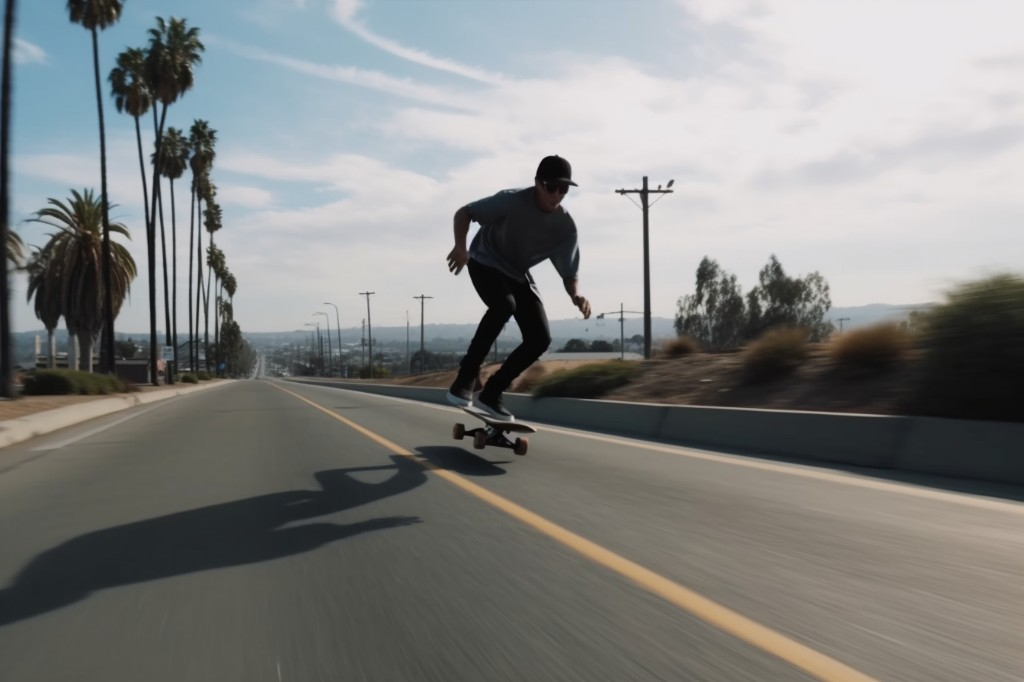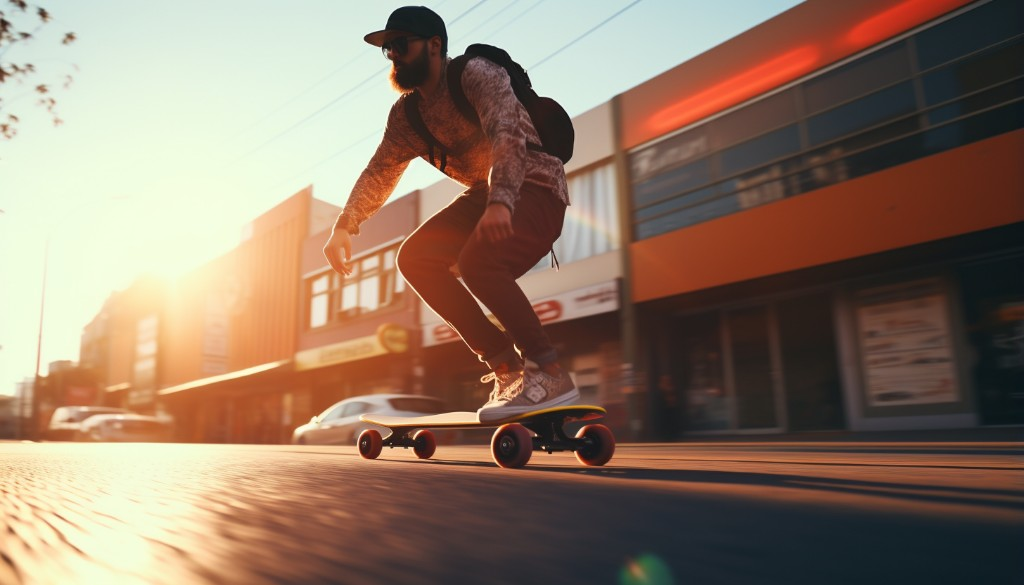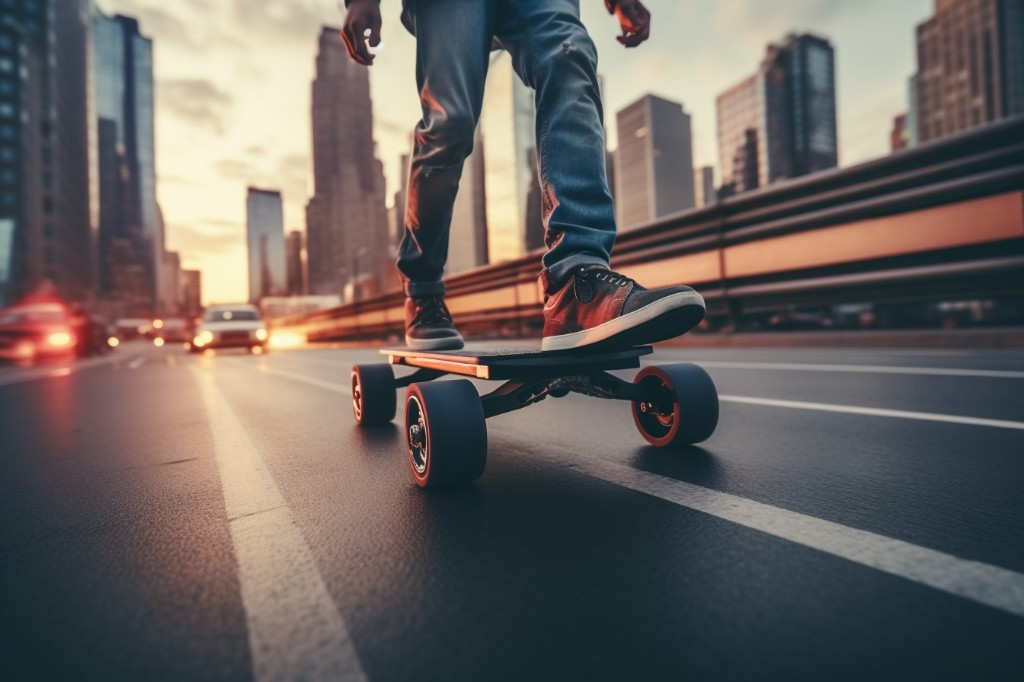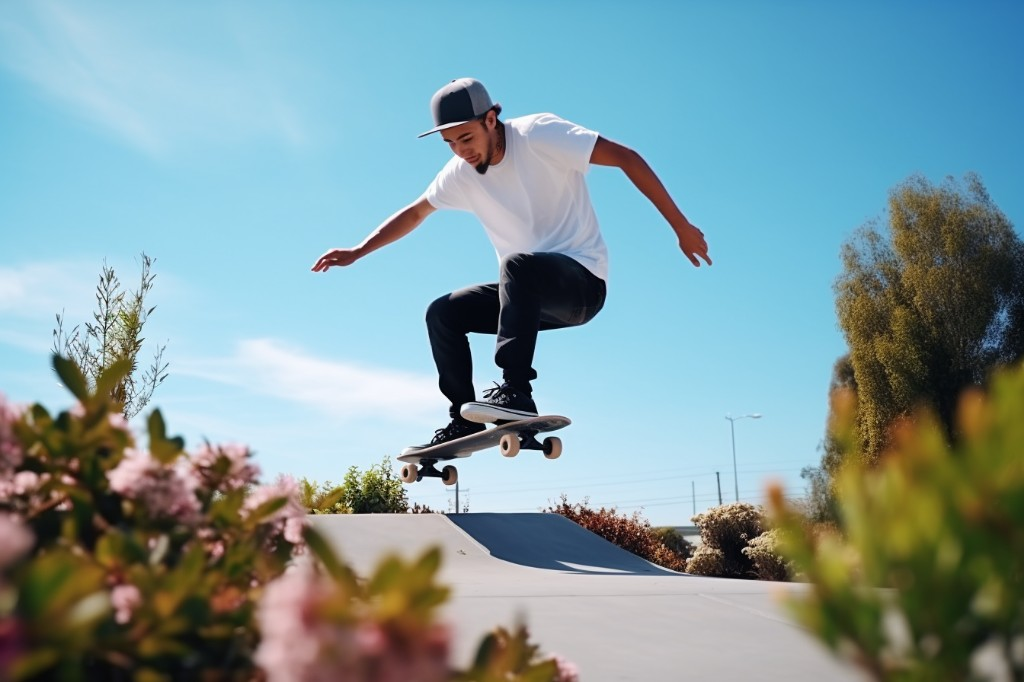Imagine gliding on an electric skateboard, the wind in your hair, the thrill of speed, and the sense of freedom rushing through your veins. But then, a lack of control or a sudden imbalance could instantly ruin this exhilarating experience. What if we told you the key to a smooth and confident ride lies in your foot positioning? Welcome to our ultimate guide on electric skateboarding and foot positioning tips, designed to equip you with the knowledge and skills for a controlled, comfortable, and most importantly, safe ride.
What we’ll cover:
- Electric Skateboarding Basics
- Finding Your Skateboarding Stance
- Optimum Control through Foot Placement
- Advanced Foot Positioning Secrets
- Electric Skateboarding Safety Measures
- Keeping Your Electric Skateboard in Top Shape
Let’s kick off this electrifying journey and show you why foot positioning is your secret weapon for an incredibly smooth ride!
Understanding the Basics of Electric Skateboarding
Electric skateboarding is a fascinating hobby that has been gaining popularity over the years. This popularity can be attributed to the unique fusion of technology and tradition that electric skateboarding represents. But to truly appreciate and enjoy this activity, one must understand the basics of electric skateboarding.
An integral part of the electric skateboard is its structure, which often consists of a board (deck), trucks, wheels, and a specially designed motor. The deck is typically made from durable materials such as maple or bamboo to withstand the rider’s weight and external elements. The trucks attach the wheels to the deck, and they aid in steering and balancing the board.
The electric skateboard’s distinct feature is its motor power, which propels the board forward without any physical pushing from the rider. The motor’s power varies among different models, making it crucial for beginners to start with lower-powered boards before transitioning to more powerful ones.

Another important aspect of an electric skateboard is the speed controller. Integrated into the board, it manages the power supply from the battery to the motor, determining the skateboard’s speed. Most electric skateboards come with a wireless remote, allowing riders to control their speed conveniently without having to touch the board itself.
Riding an electric skateboard requires a certain degree of finesse. The operation of the skateboard depends on factors such as rider weight, balance, and ability to use the wireless remote effectively. Rider weight plays a significant role in maneuvering the skateboard because shifting weight influences direction and speed.
Identifying Your Skateboarding Stance
When learning to ride an electric skateboard, it’s critical to identify your skateboarding stance. Your stance refers to how you position yourself on the skateboard. The two primary stances are regular or goofy.
Regular stance implies that you ride with your left foot forward and use your right foot for pushing and steering. Conversely, goofy stance means you ride with your right foot forward and use your left foot for pushing and steering. Your dominant foot influences whether you’ll take a regular or goofy stance.
Remember that neither stance is superior to the other – it’s entirely about what feels most comfortable and natural for you. Novice riders may need some time to figure out their preferred stance and style of riding.

Mastering Foot Placement for Optimum Control
Achieving optimum control when riding an electric skateboard involves mastering your foot placement. Where you place your feet on the board determines your stability and ability to maneuver effectively.
Firstly, consider your front foot. This foot helps guide the direction of your electric skateboard. As a rule of thumb, your front foot should be placed across the board at approximately a 45° angle, close to the front bolts.
On the other hand, your back foot should be positioned near the tail of your electric skateboard. You can adjust the angle based on your comfort level and riding style. This back foot plays a crucial role in pushing, turning, and performing tricks.
Next, let’s discuss weight distribution. When you’re riding an electric skateboard, it’s crucial to distribute your body weight correctly for optimal balance and control. Generally, you should put your weight more on your front foot when you’re cruising or accelerating.
When making turns or carving, try shifting your weight to the front foot initially before gradually transferring it towards your back foot for a smoother turn. Adjust your body weight as needed when going over bumps or uneven surfaces.
Finally, remember that foot placement isn’t a one-size-fits-all concept. As you spend more time on your electric skateboard, you’ll develop your unique style and preference for where you place your feet. Practice makes perfect in this regard! Keep practicing different foot placements while considering safety measures until you find what works best for you.

Advanced Foot Positioning Techniques
Good foot positioning is key to controlling your board during electric skateboarding. Mastering advanced techniques like heel-toe carving and drifting can significantly enhance your ride by allowing smooth turns and improved balance. Here’s how you can shift your weight effectively for better control.
Heel-Toe Carving Technique
In Heel-toe carving, you use the heels and toes of your feet to shift your weight on the board. This facilitates smooth turns without losing balance. When you want to turn right, lean back and press down on the heel of your right foot while lifting the toe slightly up. To turn left, just do the opposite.
Shifting Weight for Acceleration and Deceleration
To accelerate smoothly on your electric skateboard, lean forward slightly while keeping your knees bent for balance. Conversely, when you need to slow down or stop, shift your weight back and lean back slightly. Be sure to adjust your body position gradually to maintain control over your board.
Tricks on an Electric Skateboard
Once you’ve mastered these basics, you can start exploring tricks on an electric skateboard. Remember to always prioritize safety over showmanship. Never attempt advanced skateboarding tricks without wearing all necessary safety gear and ensure you’re in a safe environment where you won’t endanger others.

Understanding Complex Maneuvers
Expanding your skateboarding skills to include complex maneuvers such as power slides and hill bombing can significantly enhance your riding experience. Delving into these complex maneuvers requires a comprehensive understanding of the techniques involved, as well as ample practice to perfect them.
Power Slides
Power slides are a great way to show off your skills and add an element of thrill to your ride. This maneuver involves shifting your weight on the board to slide sideways, all while maintaining control and balance. A successful power slide is a testament to your skill level, showcasing your ability to manipulate the skateboard under challenging circumstances.
Hill Bombing
Next on the list is hill bombing, another complex maneuver that involves riding down a steep hill at high speeds. This can be a real adrenaline rush, but it also demands a high level of control and precision. It’s crucial to maintain a stable stance, control your speed, and stay alert to the terrain and any potential obstacles. Hill bombing is not for the faint-hearted, but mastering it can provide an unmatched sense of achievement.

Learning Adaptive Riding Techniques
Being able to adapt to different terrains and weather conditions is an essential part of skateboarding. Adaptive riding techniques such as kick pushing and foot braking can significantly improve your ability to navigate through diverse conditions.
Kick Pushing Technique
The kick push technique is fundamental to skateboarding. It’s how you generate momentum and maintain speed. Learning to kick push effectively involves planting one foot on the skateboard and using the other to push off the ground. You’ll need to use this technique frequently — so don’t be surprised if you need to kick push four times or more during a single ride!
Foot Braking Technique
Equally important is the foot braking technique, which allows you to control your speed or come to a complete stop. This technique involves slowly lowering your back foot to the ground and applying pressure until you slow down or stop. Understanding foot braking and practicing it regularly can contribute significantly to safe riding, especially when you’re navigating through different terrains or dealing with unfavorable weather conditions.
Enhancing Your Riding Skills
When it comes to skateboarding — and specifically, riding your electric skateboard — there’s always room for improvement. One of the keys to enhancing your riding skills is constant practice. The more time you spend on your board, the more comfortable you’ll become.
Becoming comfortable on your board isn’t just about getting better at tricks or learning new maneuvers. It’s also about gaining confidence in your abilities, knowing that you can handle whatever comes your way while riding your electric skateboard.
Building confidence also comes from understanding your comfort level. You don’t have to push yourself to attempt complex maneuvers or ride on challenging terrains until you feel ready. Part of improving is understanding where your boundaries are and gradually pushing them as you gain more experience.
But remember, it’s not all about pushing boundaries. Safety should always be the priority when riding your electric skateboard. So, always take the necessary precautions, follow traffic rules, and most importantly, ride safely.
By practicing regularly, adapting to different terrains, learning new techniques, and building confidence, you can enhance your skills and truly enjoy the unique experience that electric skateboarding offers.

Safety Measures for Electric Skateboarding
When it comes to electric skateboarding, safety should always be your top priority. Even the most experienced riders can fall, and with speeds reaching up to 25 miles per hour, a tumble can result in serious injury if you’re not wearing the proper safety gear. You’re infinitely more likely to experience a fall if you’re a beginner learning their ideal stance and perfect foot placement, so ensure you’re aware of the safety measures available to offer you maximum protection.
The trick to enjoying this thrilling activity is to master how to skateboard safely. It’s not just about getting from point A to B; it’s about doing so while preventing accidents and minimizing your risk of injury. This means understanding what safety equipment to wear and how to handle your board effectively. But what does this entail? Let’s find out.
Use Proper Safety Gear
To ride an electric skateboard safely, you must use the right safety gear. This includes a helmet, knee pads, elbow pads, and wrist guards – as a minimum. These items will protect your most vulnerable body parts during a fall and can be the difference between a minor scrape and a trip to the hospital. We’ll discuss appropriate safety gear in more detail shortly.
Observe Safety Precautions
Additionally, safe electric skateboarding involves adhering to traffic rules and being mindful of your surroundings. This means you should always give way to pedestrians, and avoid areas with heavy traffic or poor visibility. Also, remember to keep a safe distance from other skateboarders to avoid collisions.

Essential Gear for Safe Electric Skateboarding
Now that you know the importance of using safety gear, let’s delve into what exactly you need for optimal protection.
Helmet
First and foremost, a helmet is essential. Your head is the most critical body part you need to protect while skateboarding. A helmet will protect your skull and brain in case of a fall. Remember, traumatic brain injuries can be life-altering or even fatal.
Knee Pads and Elbow Pads
Next up are knee pads and elbow pads. These will protect your joints from impact during falls. Knee and elbow injuries can be quite severe, leading to long recovery times and even permanent damage.
Wrist Guards and Slide Gloves
Lastly, don’t forget about wrist guards and slide gloves. Wrist injuries are common among skateboarders due to the instinctual habit of breaking falls with outstretched hands. Wrist guards will protect your wrists from sprains or fractures while slide gloves will enhance your grip on the board and help you execute advanced maneuvers safely.
Additional Safety Gear
Some brands also produce padded shorts, jackets and back protectors. If you intend to perform tricks or ride at higher speeds, for example, you may want to consider purchasing additional items such as these to increase your level of protection.

Electric Skateboard Maintenance
Keeping your electric skateboard in top shape is an essential element of being an electric skateboarder. It’s not only about the smooth rides, but also about prolonging the lifespan of your board. The maintenance of your electric skateboard can be compared to taking care of a beloved pet. Just like you would groom your pet, regular cleaning of the skateboard plays a big part in its overall health. It’s a simple process that includes wiping down your board and removing any dirt or debris that might have collected. If your skateboard is in prime condition, you can comfortably focus on perfecting your stance and honing your riding techniques.
Checking and Maintaining Wheels and Trucks
The wheels and trucks of your electric skateboard are crucial components that need regular checking. The wheels, those circular items that get you moving, can wear out or get damaged, affecting your ride quality and safety. Always ensure they are in good condition before going for a ride.
Now, let’s talk about the trucks – they are like the steering mechanism of your skateboard. They attach the wheels to the deck and allow you to turn. Maintaining them involves checking for any signs of damage and ensuring all parts are tight and secure.
Bearing Maintenance
Then there are the bearings; those little circles inside your wheels that help them spin. These little guys are susceptible to dirt and dust which can slow down your wheels or even cause them to seize up completely. Cleaning of electric skateboard bearings should be done with a specialized cleaner to remove grime effectively.

Closing Thoughts
Electric skateboarding – a thrilling and eco-friendly mode of transportation that provides an exciting experience. Understanding the basics of electric skateboarding is the key to mastering this adventurous ride. An integral part of this journey is identifying your skateboarding stance, as it significantly impacts your control and balance. Alongside this, mastering foot placement is also essential for optimum control, enhancing your riding skills and experience. To augment your skills further, advanced foot positioning techniques can be learned with practice and patience. While learning these new skills, safety must never be compromised. Therefore, one must be knowledgeable about the necessary safety measures, such as wearing protective gear, when riding an electric skateboard.
Electric skateboarding is a thrilling sport that offers lots of fun and excitement. Start by perfecting your stance and you’ll soon be ready to move onto more advanced tricks and techniques. However, skateboarding also requires responsibility for ensuring safety at all times. By following the tips in this guide, you’ll be well on your way to enjoying this activity safely!
Frequently Asked Questions
What is the correct foot positioning on an electric skateboard?
The ideal foot positioning on an electric skateboard would involve keeping your feet shoulder-width apart, with the front foot angled slightly forward and the back foot across the width of the board.
How does my stance affect my riding experience?
Your stance on an electric skateboard plays a crucial role in your riding experience. A correct stance helps maintain balance, control speed, and maneuver turns effectively which overall enhances your riding experience.
What safety measures should I take when riding an electric skateboard?
Safety should always be paramount when riding an electric skateboard. Always wear protective gear like a helmet, elbow pads, and knee pads. Additionally, be aware of your surroundings, do not exceed speed limits, and avoid dangerous terrains.
What gear is essential for safe electric skateboarding?
Essential gear for safe electric skateboarding includes a high-quality helmet, elbow pads, knee pads, and wrist guards. Some riders also choose to wear padded jackets or shorts for additional protection.
How does regular maintenance extend my skateboard’s lifespan?
Regular maintenance of your electric skateboard can significantly extend its lifespan. This includes checking and tightening bolts, cleaning and lubricating bearings, checking battery levels, and inspecting wheels for any wear and tear, ensuring a smooth and safe ride every time.
